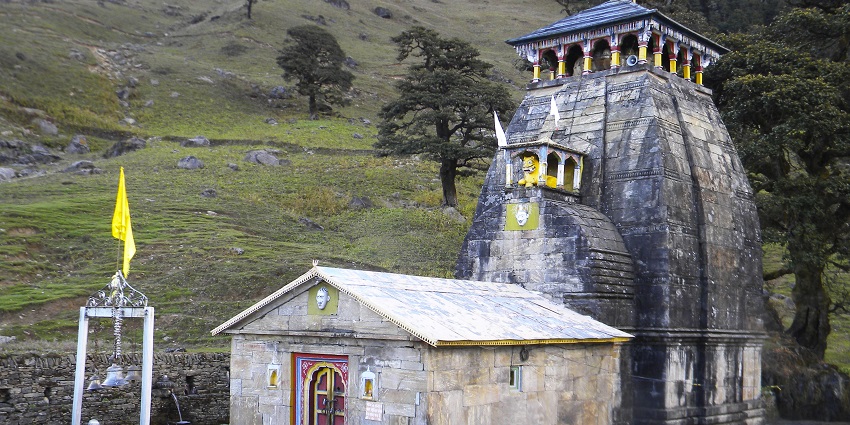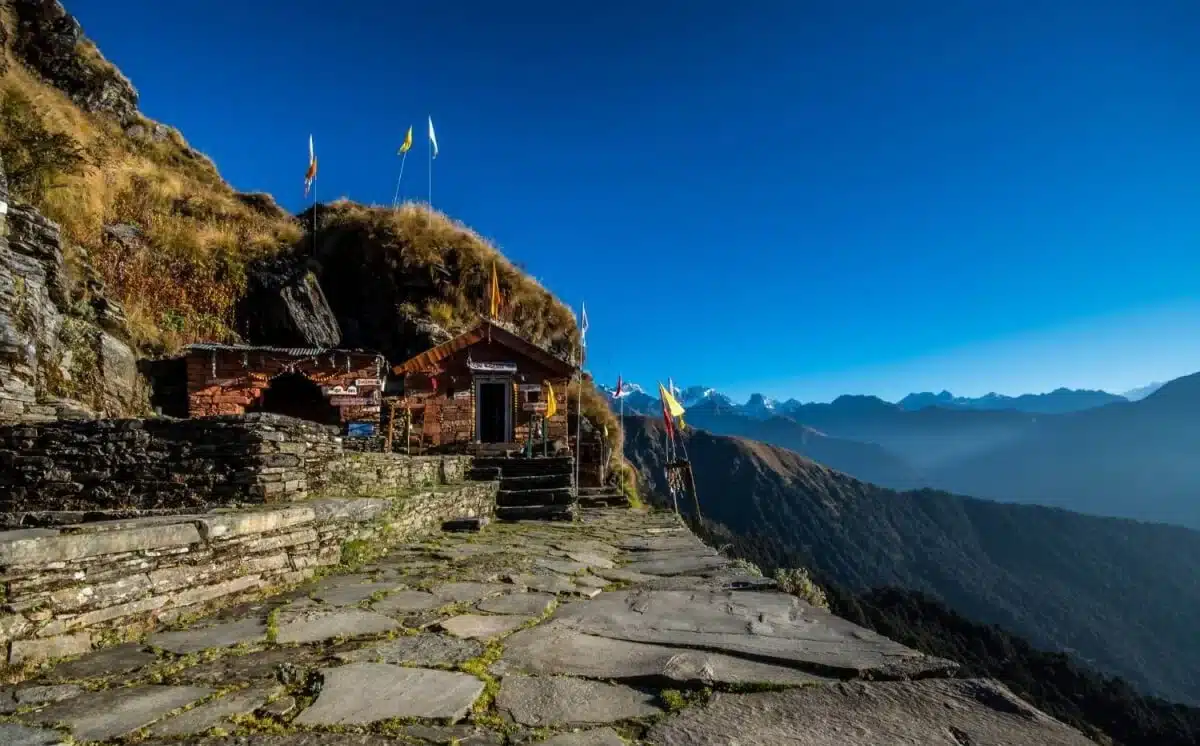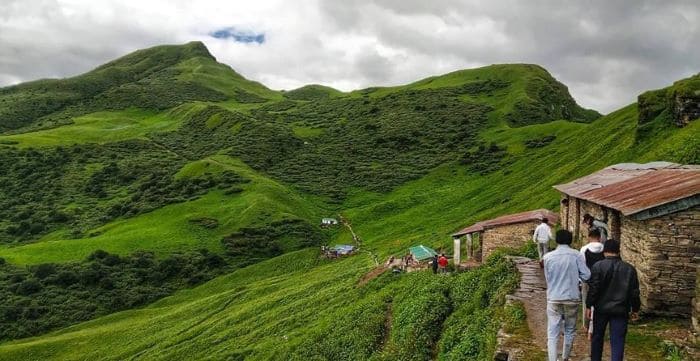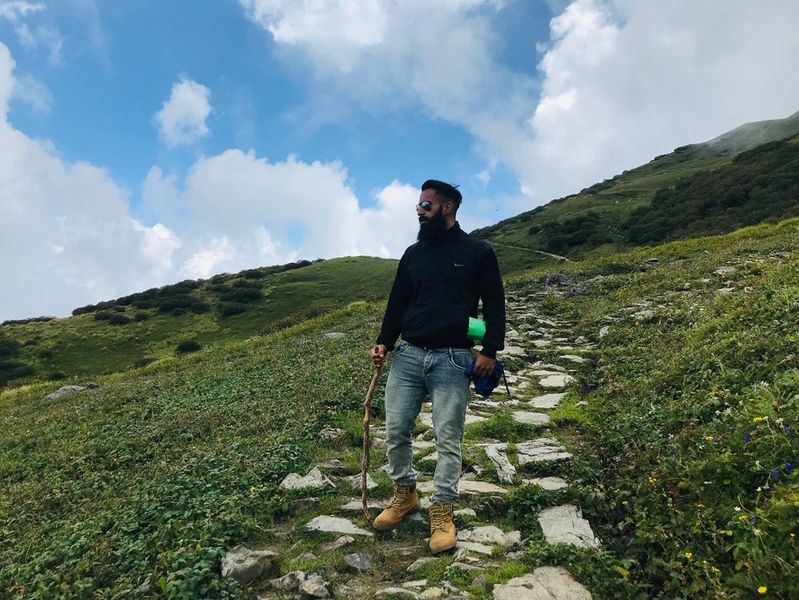Kalpeshwar Rudranath travel guide and itinerary
Published on November 14, 2025
Nestled high in the majestic Garhwal Himalayas, the Rudranath trek offers more than just a journey through rugged landscapes—it is a spiritual passage that connects trekkers with centuries-old traditions. As part of the revered Panch Kedar trek, Rudranath and Kalpeshwar temple hold deep religious significance, drawing pilgrims and adventure enthusiasts alike. The trek from Kalpeshwar from Delhi is a perfect blend of serene valleys, dense forests, and cascading waterfalls, making it a must-experience Himalayan adventure. Every step on this trail not only challenges the body but also calms the mind, offering a unique opportunity to witness nature’s untouched beauty while soaking in the sacred aura of these ancient temples. Whether you are a devotee seeking blessings or a trekker chasing panoramic views, this journey promises memories that linger long after the Himalayas fade from sight.

Kalpeshwar and Rudranath: A Spiritual Overview
The sacred circuit of the Rudranath Kalpeshwar trek is more than a physical journey; it is a spiritual pilgrimage that has drawn devotees for centuries. Kalpeshwar temple, perched amidst serene deodar forests, is the final stop in the revered Panch Kedar pilgrimage and is dedicated to Lord Shiva. Its tranquil surroundings and ancient stone architecture create an aura of peace that resonates deeply with every visitor.
The trek between the two holy sites, the Rudranath to Kalpeshwar distance, spans approximately 20–22 kilometers, winding through dense forests, sparkling streams, and scenic meadows. Every step on this path feels like a bridge between devotion and nature, offering glimpses of panoramic Himalayan peaks and hidden waterfalls. Whether you are traversing it for spiritual fulfillment or to soak in the Himalayan wilderness, the Rudranath Kalpeshwar trek provides a rare harmony of adventure and divinity.
Rudranath to Kalpeshwar Distance and Route Details (Stepwise)
Step 1: Starting Point – Rudranath
-
Begin your journey at Rudranath, one of the sacred Panch Kedar temples.
-
The surrounding alpine meadows and coniferous forests create a peaceful, spiritual setting.
-
This is where your Rudranath trek officially starts toward Kalpeshwar.
Step 2: Understanding the Distance
-
The Rudranath Trek distance to Kalpeshwar is approximately 20–22 kilometers.
-
The trail is moderate in difficulty, suitable for trekkers with basic to intermediate fitness.
-
Knowing the Kalpeshwar trek distance helps plan stops and overnight halts if needed.
Step 3: Initial Descent through Forested Trails
-
The first few kilometers involve a gentle descent through dense oak, rhododendron, and deodar forests.
-
Small streams and waterfalls along the way offer natural resting spots.
-
This section provides opportunities to spot Himalayan birds and wildlife.
Step 4: Crossing Alpine Meadows and Valleys
-
Midway, the trail opens into green alpine meadows with panoramic views of snow-capped peaks.
-
Local shepherds’ huts and grazing yaks give a glimpse of Himalayan rural life.
-
Ideal spots for photography and short breaks.
Step 5: Small Hamlets and Local Interaction
-
As you approach lower altitudes, you’ll pass through tiny Himalayan hamlets.
-
Interacting with locals can provide insights into the culture and spiritual traditions of the region.
Step 6: Final Approach to Kalpeshwar Temple
-
The last few kilometers lead gently uphill to Kalpeshwar temple, nestled amidst thick forests.
-
This is a calm and spiritual endpoint, perfect for reflection after the trek.
-
Trekkers can choose to rest here or continue exploring nearby trails and streams.
Step 7: Trek Completion
-
The journey covers the Rudranath to Kalpeshwar distance in roughly one long day or two shorter days depending on your pace.
-
Completing this trek leaves you with a sense of accomplishment, having combined adventure with spiritual fulfillment.

Best Time to Visit Kalpeshwar and Rudranath
The Rudranath Kalpeshwar trek can be enjoyed throughout the year, but each season offers a unique experience. From Kalpeshwar from Delhi, planning your visit according to the month ensures a safe and memorable journey.
January – February: These winter months are the coldest, with temperatures ranging from -5°C to 5°C. Heavy snowfall blankets the trail, making the Rudranath trek challenging yet magical. The serene, snow-covered surroundings of Kalpeshwar temple offer a tranquil spiritual experience, ideal for those seeking solitude and the beauty of winter in the Himalayas.
March – April: As spring arrives, temperatures rise to 5°C–12°C, and the snow begins to melt. The trails become more accessible, making it easier to cover the Rudranath to Kalpeshwar distance. Early spring flowers start to bloom along the trail, adding vibrant colors to the verdant forests. This is a perfect time for trekkers who want a balance between mild trekking conditions and scenic beauty.
May – June: The months before the monsoon bring pleasant and mild weather, with temperatures between 12°C and 20°C. Trails are clear and safe, making it the best period for the Rudranath Kalpeshwar trek. From Kalpeshwar from Delhi, trekkers can enjoy crystal-clear skies, panoramic Himalayan views, and lush green valleys, making this the peak season for both adventure and spiritual seekers.
July – August: Monsoon arrives with heavy rainfall and temperatures around 10°C–18°C. Trails become slippery, and landslides may occur, making trekking risky. While the forests look lush and vibrant, visiting Kalpeshwar temple during this time can be challenging, so these months are generally not recommended for trekking.
September – October: Post-monsoon months offer clear skies, mild temperatures (12°C–20°C), and excellent trekking conditions. The Rudranath trek becomes comfortable, and the views of golden autumn forests and snow-capped peaks are breathtaking. This is an ideal time for pilgrims and trekkers alike, providing a mix of serenity and adventure.
November – December: Early winter brings crisp air and temperatures ranging from 0°C to 10°C. Trails may experience the first snowfalls, adding a magical charm to the journey. Trekking is moderately challenging, but the quiet trails and peaceful ambiance of Kalpeshwar temple make it a spiritually rewarding experience.
| Month | Temperature (°C) | Trekking Conditions | Highlights & Experience |
|---|---|---|---|
| January – February | -5°C to 5°C | Challenging due to heavy snowfall | Snow-covered trails, serene and peaceful Kalpeshwar temple, ideal for solitude |
| March – April | 5°C to 12°C | Moderate; snow melting makes trails accessible | Early spring blooms, colorful forests, easier Rudranath trek |
| May – June | 12°C to 20°C | Clear and safe; ideal trekking period | Crystal-clear skies, panoramic Himalayan views, lush green valleys; best time for Rudranath Kalpeshwar trek |
| July – August | 10°C to 18°C | Slippery trails, landslide risk | Lush green scenery during monsoon; trekking not recommended |
| September – October | 12°C to 20°C | Excellent trekking conditions | Golden autumn forests, crisp air, ideal for both spiritual and adventure seekers |
| November – December | 0°C to 10°C | Moderate; first snowfalls may appear | Quiet trails, snow-dusted landscapes, peaceful Kalpeshwar temple experience |

Preparing for the Rudranath Kalpeshwar Trek
Embarking on the Rudranath trek is both an adventurous and spiritual journey, and proper preparation ensures you make the most of this sacred Himalayan experience. Covering the Rudranath Trek distance of approximately 20–22 kilometers to Kalpeshwar, this trek is moderately challenging and requires physical readiness, mental focus, and thoughtful planning.
If you’re traveling from cities like Delhi, opting for a Rudranath and Kalpeshwar trek package can simplify logistics, including transportation, accommodation, meals, and local guidance. These packages are especially helpful for first-time trekkers, as they provide structured itineraries and professional support along the trail.
For a seamless trek, choosing the right Rudranath Trek package is crucial. Look for options that include experienced guides, clear trail maps, and essentials like packed meals and comfortable stays. Physical preparation is equally important—regular cardio, brisk walking, and light hiking in advance can significantly improve stamina for covering the Rudranath Trek distance comfortably.
Packing smart is another key aspect. Layered clothing for changing temperatures, sturdy trekking shoes, a reliable backpack, water bottles, and trekking poles make the journey safer and more enjoyable. Additionally, carrying basic medical supplies and personal identification ensures peace of mind along the way.
By combining physical readiness, thoughtful planning, and the right Rudranath and Kalpeshwar trek package, you can fully embrace the spiritual and natural beauty of this sacred Himalayan route, making the trek a memorable adventure that harmonizes both devotion and exploration.
Essential Gear and Packing Tips for the Trek
Proper gear and packing can make the Rudranath Kalpeshwar trek safe, comfortable, and enjoyable. Here’s a stepwise guide to help you prepare:
Step 1: Clothing Essentials
-
Pack layered clothing to adapt to fluctuating Himalayan temperatures.
-
Include thermal innerwear, quick-dry t-shirts, fleece jackets, and a waterproof outer layer.
-
Don’t forget gloves, a warm cap, and woolen socks for higher altitudes.
Step 2: Footwear
-
Sturdy trekking shoes with good grip are a must for navigating rocky and uneven trails.
-
Bring extra socks to keep your feet dry and blister-free.
Step 3: Backpack Essentials
-
A comfortable backpack with adjustable straps to carry your daily essentials.
-
Include a rain cover to protect your belongings during unexpected showers.
Step 4: Hydration and Nutrition
-
Carry at least 2–3 liters of water or a hydration pack.
-
Pack energy bars, dry fruits, and light snacks to fuel your trek along the way.
Step 5: Navigation and Safety
-
Keep a map of the Rudranath trek or use GPS apps to track your route.
-
Include a first-aid kit, sunscreen, lip balm, trekking poles, and a flashlight with extra batteries.
Step 6: Camping and Accommodation Extras
-
If your Rudranath and Kalpeshwar trek package includes camping, pack a lightweight sleeping bag and a compact sleeping mat.
-
Earplugs and a small towel can add comfort during overnight stays.
Step 7: Personal and Miscellaneous Items
-
Carry identification, cash, and any required permits.
-
A camera or smartphone to capture the breathtaking landscapes.
-
Biodegradable toiletries and waste bags to maintain eco-friendly trekking practices.
Following these tips ensures that your trek is safe, enjoyable, and well-prepared, letting you focus on the spiritual and natural beauty of the Rudranath Kalpeshwar trek without unnecessary stress or discomfort.

Day-Wise Itinerary: Kalpeshwar Rudranath Trek
DAY 1: Rishikesh to Sagar Village
- Distance: Approximately 220 km, 7-8 hours
- Route: Rishikesh to Sagar Village via Koteshwar, Rudraprayag, and Agasthmuli
- Accommodation: Stay overnight in Sagar Village
DAY 2: Sagar village to Leuti/Pannar Bugyal
- Distance: Approximately 10 km, 5-6 hours
- Altitude Gain: 2,800 ft to 7,000 ft
- Terrain: Gradual ascent through forests and meadows
- Accommodation: Stay overnight in Leuti or Pannar Bugyal
DAY 3: Leuti/Pannar Bugyal to Rudranath
- Distance: Approximately 6 km, 5-6 hours
- Altitude Gain: 7,000 ft to 11,800 ft
- Terrain: Steep ascent to the temple
- Accommodation: Stay overnight near Rudranath Temple
DAY 4: Rudranath to Sagar village
- Distance: Approximately 16 km, 7-8 hours
- Terrain: Descent through forests and meadows
- Accommodation: Stay overnight in Sagar Village
DAY 5: Sagar to Rishikesh
- Distance: Approximately 220 km, 7-8 hours
- Route: Sagar Village to Rishikesh via Koteshwar, Rudraprayag, and Agasthmuli
- Return: End of the trek

Accommodation and Food Options on the Trek
While trekking the sacred Rudranath trek, comfort and sustenance are essential for an enjoyable journey. The trail connecting Rudranath to Kalpeshwar temple offers a mix of basic accommodations and simple eateries, perfect for rejuvenating after a day on the mountains.
Accommodation Options:
-
Along the trail, trekkers can find guesthouses and dharamshalas in small Himalayan hamlets. These provide basic facilities such as clean bedding, hot water (seasonal), and a cozy place to rest.
-
For those opting for a Rudranath and Kalpeshwar trek package, many operators include pre-booked stays, which ensure comfort without the hassle of searching for lodgings mid-journey.
-
Some trekking packages also offer camping arrangements in scenic meadows, allowing trekkers to experience the Himalayan night sky under a blanket of stars.
Food Options:
-
Simple, local cuisine dominates the trek route—dal, rice, chapati, and seasonal vegetables are staples at local dhabas.
-
For trekkers on guided packages, meals are often included, ensuring nutritious and hygienic food is available without interruptions to the trek.
-
Carrying energy bars, dry fruits, and instant snacks is recommended to keep energy levels up during long stretches of the Rudranath trek.
Whether you choose structured packages or independent trekking, the combination of local accommodations and homemade-style meals adds a warm, personal touch to the journey. Staying in these humble yet welcoming spots along the trail allows trekkers to soak in the natural beauty, experience Himalayan hospitality, and fully enjoy the spiritual ambiance of the Panch Kedar trek.

Safety Tips and Health Precautions for High-Altitude Trekking
The Rudranath trek is an incredible Himalayan journey, but the combination of altitude, rugged terrain, and variable weather requires careful preparation. Understanding safety measures and health precautions ensures that the Rudranath Trek distance is covered comfortably and without unnecessary risks.
1. Acclimatize Properly
-
Ascend gradually to let your body adjust to high altitudes.
-
Avoid rushing through the Kalpeshwar trek distance; take breaks and allow time to acclimatize to prevent altitude sickness.
2. Stay Hydrated
-
Drink plenty of water throughout the trek. Dehydration can worsen altitude-related symptoms.
-
Carry a reusable water bottle and refill it at streams or guesthouses along the Rudranath trek.
3. Pack Smart and Light
-
Carry essential gear like warm clothing, sturdy trekking shoes, and a first-aid kit.
-
Overpacking can strain your back and slow you down on long stretches of the Rudranath Trek distance.
4. Listen to Your Body
-
Pay attention to signs of fatigue, dizziness, or headaches.
-
If symptoms of altitude sickness appear, rest immediately and consider descending slightly before continuing.
5. Trek in Groups or With Guides
-
Opting for a guided Rudranath and Kalpeshwar trek package ensures professional support, especially in remote stretches.
-
Traveling in groups increases safety and provides assistance in case of emergencies.
6. Follow Trail Etiquette
-
Stick to marked trails and avoid taking shortcuts that could be dangerous.
-
Respect the natural environment and local communities along the Kalpeshwar trek distance.
7. Carry Essential Medications
-
Keep medications for common issues like headaches, stomach upsets, and cold symptoms.
-
A basic first-aid kit can make a big difference when trekking the Rudranath trek.
By keeping these safety and health tips in mind, trekkers can confidently cover the Rudranath Trek distance, enjoy the breathtaking Himalayan scenery, and reach Kalpeshwar temple safely, making the journey spiritually fulfilling as well as physically rewarding.

How to Reach Kalpeshwar and Rudranath from Major Cities
Reaching the sacred sites of Kalpeshwar temple and Rudranath is an adventure in itself, and proper planning ensures a smooth start to the Rudranath trek. Whether you are traveling from Delhi or nearby cities, several options are available to suit different preferences.
From Delhi:
-
By Road: The most convenient way is via road, covering roughly 520–550 km to reach the base point at Helang or Sagar, depending on the chosen trail. A journey from Kalpeshwar from Delhi typically takes 12–14 hours by car or bus. Private cabs or self-drive vehicles offer flexibility for sightseeing en route.
-
By Train: While there’s no direct train to the trailhead, travelers can take a train to Haridwar or Rishikesh, then hire taxis or join a Rudranath and Kalpeshwar trek package that includes transport to the base.
From Haridwar / Rishikesh / Dehradun:
-
These cities act as gateway hubs. From here, shared taxis, buses, or organized trek packages provide access to the starting points of the Rudranath trek. Travel times vary from 8 to 12 hours depending on the exact route and road conditions.
By Air:
-
The nearest airport is Dehradun’s Jolly Grant Airport. From the airport, travelers can hire taxis or use organized trek services to reach the base of the Rudranath trek and eventually proceed toward Kalpeshwar temple.
Tips for the Journey:
-
Opting for a Rudranath and Kalpeshwar trek package from Delhi often simplifies logistics, covering transport, local guidance, and accommodation.
-
Start early in the morning to avoid traffic and reach the trailhead with enough daylight.
-
Carry essential trekking gear and snacks for the road, especially if traveling by shared transport.
Planning your route carefully ensures a stress-free journey to the Himalayas and allows you to fully enjoy the spiritual and natural beauty of the Rudranath trek and Kalpeshwar temple.
Local Culture and Spiritual Significance
The Rudranath trek is not just a physical journey through the Himalayas—it is also an immersion into the rich local culture and deep-rooted spirituality of the Garhwal region. The trail connecting Rudranath to Kalpeshwar temple passes through remote Himalayan villages, where traditions, festivals, and lifestyles have remained largely unchanged for centuries.
Villagers along the route are warm and welcoming, offering trekkers glimpses into a lifestyle harmonized with nature. Local customs, from folk songs to traditional cuisine, enrich the trekking experience, making the journey culturally as well as spiritually fulfilling. Pilgrims visiting the Panch Kedar trek often witness these traditions firsthand, adding depth to their sacred journey.
The spiritual significance of the trek is profound. Kalpeshwar temple, tucked away in a serene forested valley, is considered one of the holiest Shiva shrines in the region. Devotees believe that visiting this temple along the Rudranath trek purifies the soul and grants blessings. Rudranath itself holds immense religious importance, being part of the sacred Panch Kedar circuit.
Every stretch of the trek—from the dense forests to the alpine meadows—is imbued with a sense of devotion and tranquility. Observing local rituals, listening to temple chants, and witnessing pilgrims on their spiritual path allows trekkers to connect deeply with the essence of the Rudranath trek. This blend of culture, spirituality, and natural beauty makes the journey truly unforgettable for anyone visiting Kalpeshwar temple.

Photography Tips: Capturing the Himalayan Beauty
The Rudranath trek offers breathtaking landscapes at every turn, making it a paradise for photography enthusiasts. From lush deodar forests to snow-capped peaks, every scene along the trail is picture-perfect. Whether you are visiting Kalpeshwar temple or exploring the surrounding meadows, having a few photography tips in mind can help you capture the essence of this Himalayan journey.
1. Golden Hours Are Key
-
Early mornings and late afternoons provide soft, golden light that enhances the natural beauty of the Himalayas.
-
Use these hours to photograph the Kalpeshwar temple bathed in warm sunlight or the peaks glowing at sunrise and sunset.
2. Capture the Scale and Depth
-
Include foreground elements like trekking trails, rivers, or pilgrims to create a sense of scale.
-
This helps convey the vastness of the Rudranath trek landscapes in your shots.
3. Use a Tripod for Stability
-
A lightweight tripod is essential for capturing long-exposure shots of waterfalls or starry night skies during overnight stays.
4. Play with Perspectives
-
Experiment with angles—shooting from lower points can make mountains appear towering, while aerial shots (if using a drone responsibly) can showcase the full Panch Kedar trek route.
5. Respect the Sacred Spaces
-
While photographing Kalpeshwar temple or pilgrims, maintain decorum and seek permission when necessary.
-
Combining cultural sensitivity with photography ensures authentic and respectful images.
6. Keep Gear Protected
-
Himalayan weather can be unpredictable; use protective covers for cameras and smartphones to prevent moisture or dust damage.
7. Capture the Journey, Not Just Destinations
-
Include candid moments of trekking, resting by streams, or local interactions to tell the story of the Rudranath trek.
-
These photographs often evoke the emotion and serenity of the journey better than landscapes alone.
By following these tips, you can create a stunning photographic diary of your trek, capturing the natural grandeur, spiritual ambiance, and cultural richness of the Rudranath trek and the serene beauty surrounding Kalpeshwar temple.

Conclusion: Experiencing Spiritual Serenity in the Himalayas
The Rudranath trek is far more than a challenging Himalayan journey—it is a soulful adventure that blends spirituality, nature, and culture. From the sacred Kalpeshwar temple nestled among deodars to the tranquil forests and alpine meadows along the trail, every step offers a unique opportunity to reconnect with oneself and the divine.
Covering the Rudranath Trek distance between Rudranath and Kalpeshwar is not just about trekking kilometers; it is about embracing the serenity, the panoramic Himalayan vistas, and the spiritual aura of the Panch Kedar trek. Travelers from cities like Delhi, following the Kalpeshwar from Delhi route, often find that the journey refreshes both body and soul, leaving lasting memories of devotion, adventure, and natural beauty.
Whether you are a devoted pilgrim, an avid trekker, or someone seeking peace away from the hustle of city life, the Rudranath-Kalpeshwar journey promises an unparalleled experience. By respecting the trails, local culture, and sacred spaces, you can fully immerse yourself in the Himalayan spirituality while enjoying the pristine landscapes that make this trek truly unforgettable.
Frequently Asked Questions:
1. What is the distance of the Rudranath trek to Kalpeshwar?
The Rudranath Trek distance to Kalpeshwar is approximately 20–22 kilometers, depending on the chosen route and trail conditions.
2. How difficult is the Rudranath-Kalpeshwar trek?
The trek is moderately challenging, suitable for beginners with basic fitness and experienced trekkers alike. Gradual ascents and scenic trails make it manageable with proper preparation.
3. What is the best time to visit Kalpeshwar and Rudranath?
The ideal months are May to June and September to October, offering clear skies, pleasant temperatures, and safe trekking conditions. Winter and monsoon months are more challenging due to snow and rain.
4. Can I cover the Rudranath trek from Kalpeshwar in a day?
While possible for experienced trekkers, it is recommended to split the journey over 1–2 days to enjoy the scenery, rest properly, and acclimatize to the altitude.
5. Are there guided Rudranath and Kalpeshwar trek packages available?
Yes, Rudranath and Kalpeshwar trek packages include accommodations, meals, transport, and guidance, making the journey easier for first-time trekkers and those traveling from cities like Delhi.
6. How can I reach Kalpeshwar and Rudranath from Delhi?
Travelers can drive or hire taxis covering roughly 520–550 km, or take a train/flight to Haridwar, Rishikesh, or Dehradun, then continue via local transport or a guided trek package.
7. What kind of accommodation is available along the Rudranath trek?
Simple guesthouses, dharamshalas, and campsites are available. Trek packages often include pre-booked stays to ensure comfort near the Kalpeshwar temple.
8. What should I pack for the Rudranath-Kalpeshwar trek?
Essential gear includes layered clothing, trekking shoes, hydration packs, snacks, a first-aid kit, and a camera. A Rudranath Trek package often provides guidance on what to carry.
9. Is the trek suitable for solo travelers and families?
Yes, the Rudranath trek is suitable for solo travelers, groups, and families, provided they are prepared physically and follow safety precautions.
10. What makes the Rudranath-Kalpeshwar trek spiritually significant?
Both Rudranath and Kalpeshwar temple are part of the sacred Panch Kedar trek, dedicated to Lord Shiva. Visiting these sites offers a blend of devotion, cultural insight, and natural serenity.



